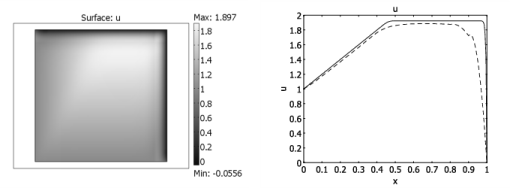A consistent stabilization method adds numerical diffusion in such a way that if u is an exact solution to
Equation 3-3, then it is also a solution to the problem with numerical diffusion. In other words, a consistent stabilization method gives less numerical diffusion the closer the numerical solution comes to the exact solution.
An inconsistent stabilization method adds numerical diffusion in such a way that if u is an exact solution to
Equation 3-3, then it is not necessarily a solution to the problem with numerical diffusion. In other words, an inconsistent method adds a certain amount of diffusion independently of how close the numerical solution is to the exact solution.
to the physical diffusion coefficient, c. Here
δid is a tuning parameter. This means that you do not solve the original problem,
Equation 3-3, but rather the modified
O(h)-perturbed problem
(3-6)

Clearly, as ||β|| approaches infinity,
Pe approaches, but never exceeds, one. While a solution obtained with isotropic diffusion might not be satisfactory in all cases, the added diffusion definitely dampens the effects of oscillations and impedes their propagation to other parts of the system. It is not always necessary to set
δid as high as
0.5 to get a smooth solution, and its value should be smaller if possible. A good rule of thumb is to select
δ = 0.5/p, where
p is the order of the basis functions. The default value is
δid = 0.25
Figure 3-26 shows the effect of isotropic diffusion on
Equation 3-5 with
δid = 0.25. Although the solution is smooth, the comparison with the reference solution in the right plot reveals that the isotropic diffusion introduces far too much diffusion.
The streamline diffusion method in the COMSOL Multiphysics software is a consistent stabilization method. When applied to Equation 3-3, it recovers the streamline upwind Petrov-Galerkin (SUPG) method, but it can also recover functionality from the Galerkin least-squares (GLS) method. Both methods are described below. For theoretical details, see
Ref. 1 and
Ref. 2.
Figure 3-27 displays the effect of SUPG on the solution of
Equation 3-5. The solution closely follows the reference solution away from the boundary layers, but at the boundary layers, oscillations occur. This is a typical behavior for streamline diffusion: the solution becomes smooth and exact in smooth regions but can contain local oscillations at sharp gradients.
(3-7)

where s is a production coefficient if
s > 0 and an absorption coefficient if
s < 0. If
s ≠ 0, the numerical solution of
Equation 3-7 is characterized by the Péclet number (see
Equation 3-4) and the element Damköhler number:
(3-8)

The (unstabilized) Galerkin discretization becomes unstable if 2DaPe > 1 (
Ref. 4), that is, if the production/absorption effects dominate over the viscous effects. GLS differs from SUPG in that GLS relaxes this requirement while SUPG does not.
1
Streamline diffusion introduces artificial diffusion in the streamline direction. This is often enough to obtain a smooth numerical solution if the exact solution of Equation 3-3 (or
Equation 3-7) does not contain any discontinuities. At sharp gradients, however, undershoots and overshoots can occur in the numerical solutions (see
Figure 3-27). Crosswind diffusion addresses these spurious oscillations by adding diffusion orthogonal to the streamline direction — that is, in the crosswind direction.
where gij is the covariant metric tensor. The coefficient
νh is for Navier-Stokes systems a modified version of the Hughes-Mallet (HM) formulation of
Ref. 6. In the scalar case, the modified HM formulation reduces effectively to the form suggested in
Ref. 6. Additionally,
Ref. 7 suggests to reduce
νh for higher-order elements. The formulation in the COMSOL Multiphysics software multiplies
νh with a factor
where N is the shape function order.
Figure 3-28 shows the example problem (
Equation 3-5) solved using streamline diffusion and crosswind diffusion. Oscillations at the boundary layers are almost completely removed (compare with
Figure 3-27), but it has been achieved by the introduction of some extra diffusion. In general, crosswind diffusion tries to smear out the boundary layer so that it becomes just wide enough to be resolved on the mesh (
Figure 3-23). To obtain a sharper solution and remove the last oscillations, the mesh needs to be refined locally at the boundary layers.

